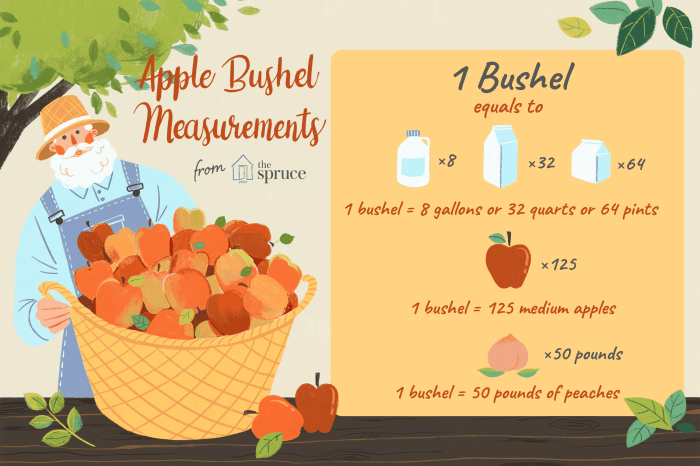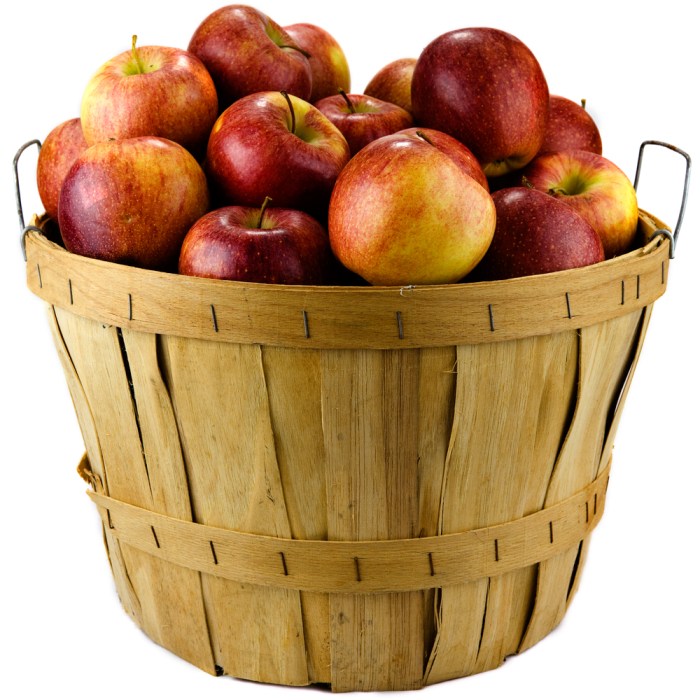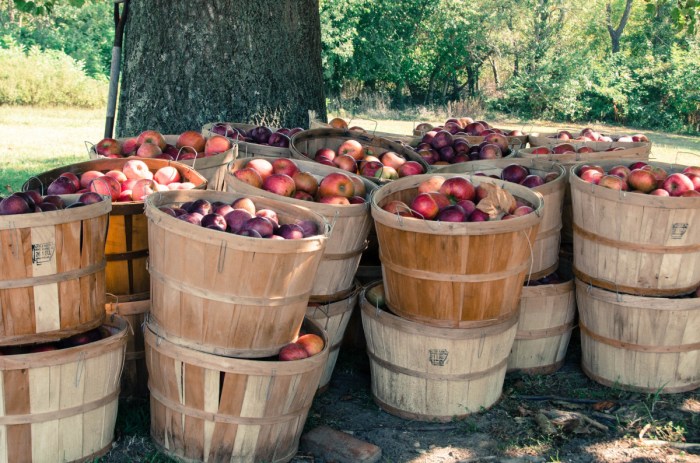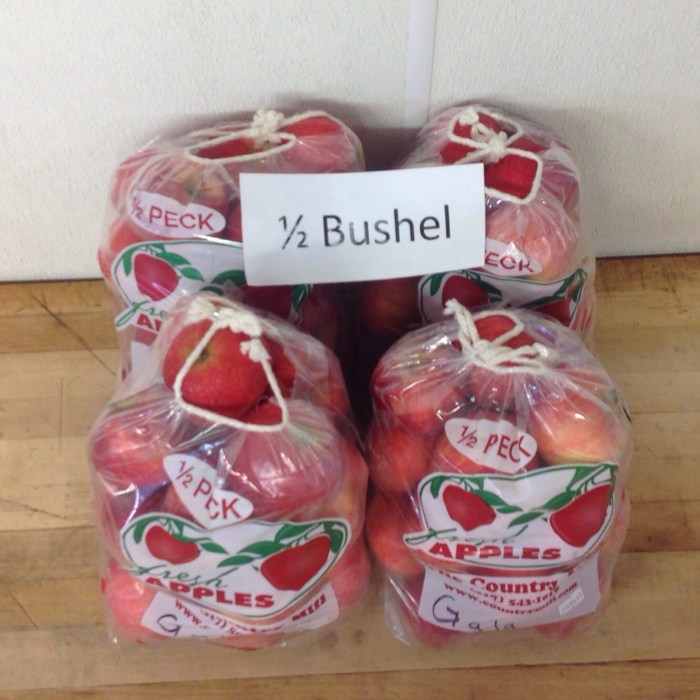Cost of bushel of apples – The cost of a bushel of apples is a multifaceted issue influenced by a myriad of factors. From production costs to market dynamics, this article delves into the complexities that shape the price of this ubiquitous fruit.
The journey of an apple from orchard to table involves a intricate web of production, distribution, and retail processes, each contributing to the final cost.
Production Costs

The cost of producing a bushel of apples varies depending on several factors, including labor, materials, and transportation. Labor costs account for a significant portion of the total production cost, as apple trees require regular pruning, spraying, and harvesting.
Materials, such as fertilizers, pesticides, and irrigation equipment, also contribute to the overall cost. Additionally, transportation costs can be substantial, especially for apples that are grown in remote areas or shipped long distances to market.
Average Production Costs
According to data from the United States Department of Agriculture (USDA), the average cost of producing a bushel of apples in the United States is approximately $10. This cost can vary significantly by region, with higher costs in areas with higher labor and transportation expenses.
Market Factors

The cost of a bushel of apples is heavily influenced by the interplay of supply and demand. When supply exceeds demand, prices tend to fall as producers compete to sell their surplus. Conversely, when demand outstrips supply, prices rise as buyers are willing to pay more to secure the limited available product.
Historical Price Trends
Analyzing historical price trends can provide valuable insights into the factors that have contributed to price fluctuations in the apple market. Factors such as weather conditions, crop yields, and consumer preferences have all played a role in shaping price movements over time.
Comparison to Other Fruits and Vegetables
Comparing the cost of apples to other fruits and vegetables can help contextualize their value. Factors such as production costs, storage requirements, and seasonality can influence the relative prices of different produce items.
Distribution and Retail Costs: Cost Of Bushel Of Apples
The journey of apples from the farm to the consumer’s table involves several steps, each contributing to the final cost of a bushel. Distribution channels play a crucial role in ensuring the timely and efficient delivery of apples to various markets.
Distribution Channels
Apples are typically distributed through multiple channels, including:
- Wholesalers:Large-scale distributors who purchase apples from farmers and resell them to retailers.
- Retailers:Grocery stores, supermarkets, and farmers’ markets that sell apples directly to consumers.
- Direct sales:Some farmers sell apples directly to consumers through farm stands or online platforms.
Seasonality and Regional Variations

The cost of a bushel of apples is influenced by several factors, including seasonality and regional variations. Seasonality refers to the time of year when apples are harvested, which affects their availability and price. Regional variations arise due to differences in production costs, transportation expenses, and local market conditions.
Seasonality
Apples are typically harvested in the fall, with different varieties becoming available at different times. Early-season varieties, such as Gala and Honeycrisp, tend to be more expensive due to their limited availability. As the season progresses and more apples become available, prices generally decline.
The cost of a bushel of apples has gone up again this year, making it more expensive to enjoy this fall treat. But don’t despair! If you’re looking for a way to enjoy the season without breaking the bank, I recommend checking out a cat in the rain review . This classic short story by Ernest Hemingway is sure to put you in the autumn spirit, and it’s completely free to read online.
So grab a cup of cider, curl up with a good book, and enjoy the changing seasons.
During the off-season, when apples are not in season, prices may rise as they are imported from other regions or stored in controlled environments. However, some varieties, such as Granny Smith, are available year-round due to controlled-atmosphere storage techniques.
Regional Variations
The cost of apples can also vary significantly across regions. Factors such as production costs, transportation expenses, and local market conditions influence regional price differences.
- Production Costs:Regions with favorable growing conditions and low labor costs may have lower production costs, leading to lower apple prices.
- Transportation Expenses:The cost of transporting apples from production areas to distribution centers and retail stores can impact prices. Apples grown in distant regions may incur higher transportation costs, resulting in higher prices.
- Local Market Conditions:Local supply and demand can affect apple prices. Regions with high demand for apples may experience higher prices, while regions with an abundance of local production may have lower prices.
Organic and Conventional Apples

Organic apples are grown without the use of synthetic pesticides, herbicides, or fertilizers. Conventional apples, on the other hand, are grown with the use of these chemicals.
Cost Difference
Organic apples are typically more expensive than conventional apples. This is due to the higher cost of production. Organic farmers must spend more money on labor, as they cannot use chemical sprays to control pests and diseases. They must also use more expensive organic fertilizers and pest control methods.
Factors Contributing to Price Difference
- Production costs: Organic farming practices require more labor, specialized equipment, and organic fertilizers, leading to higher production costs.
- Certification: Organic apples must be certified by an accredited organization, which involves additional fees and inspections.
- Market demand: Consumers are increasingly willing to pay a premium for organic products, driving up demand and prices.
- Limited supply: Organic apple production is often limited due to stricter growing standards and lower yields compared to conventional farming.
Consumer Demand
Consumer demand for organic apples has been growing in recent years. This is due to a number of factors, including:
- Health concerns: Consumers are increasingly concerned about the potential health risks associated with pesticides and other chemicals used in conventional farming.
- Environmental concerns: Consumers are also concerned about the environmental impact of conventional farming practices.
- Taste and quality: Some consumers believe that organic apples taste better and have a higher quality than conventional apples.
Global Market

International trade plays a significant role in determining the cost of a bushel of apples. Countries with favorable climates and production capabilities export their surplus apples, while those with limited production or unfavorable conditions import apples to meet their demand.
This global trade network influences the supply and demand dynamics, affecting the prices of apples in different regions.
Major Apple-Producing Countries, Cost of bushel of apples
The major apple-producing countries include China, the United States, Turkey, Poland, and Italy. These countries account for a significant portion of the global apple production and have a substantial impact on the global market. China is the largest apple producer, accounting for over half of the world’s apple production.
The United States is the second-largest producer, followed by Turkey, Poland, and Italy.The production capabilities and export strategies of these major apple-producing countries influence the global supply of apples. For instance, a bumper crop in China can lead to increased exports and lower prices in the global market.
Conversely, a poor harvest in the United States can reduce the global supply and drive up prices.
Cost of Apples in Different Countries
The cost of a bushel of apples varies significantly across countries. In general, apples are cheaper in countries with high production and lower labor costs. For example, in China, a bushel of apples can cost around $10, while in the United States, it can cost around $20. In countries with limited production and higher labor costs, such as Japan or the United Kingdom, the cost of a bushel of apples can be significantly higher, reaching up to $50 or more.The
exchange rates between currencies also affect the cost of apples in different countries. For instance, if the US dollar strengthens against the Chinese yuan, the cost of apples in the United States will decrease relative to the cost in China.
This currency fluctuation can impact the competitiveness of apple exports and imports between different countries.
Questions and Answers
What factors contribute to the cost of producing a bushel of apples?
Labor, materials, and transportation are key factors that influence production costs.
How does supply and demand affect the cost of apples?
High demand and low supply can lead to higher prices, while the opposite can result in lower prices.
What are the differences in cost between organic and conventional apples?
Organic apples typically have higher production costs due to stricter farming practices, resulting in a higher retail price.